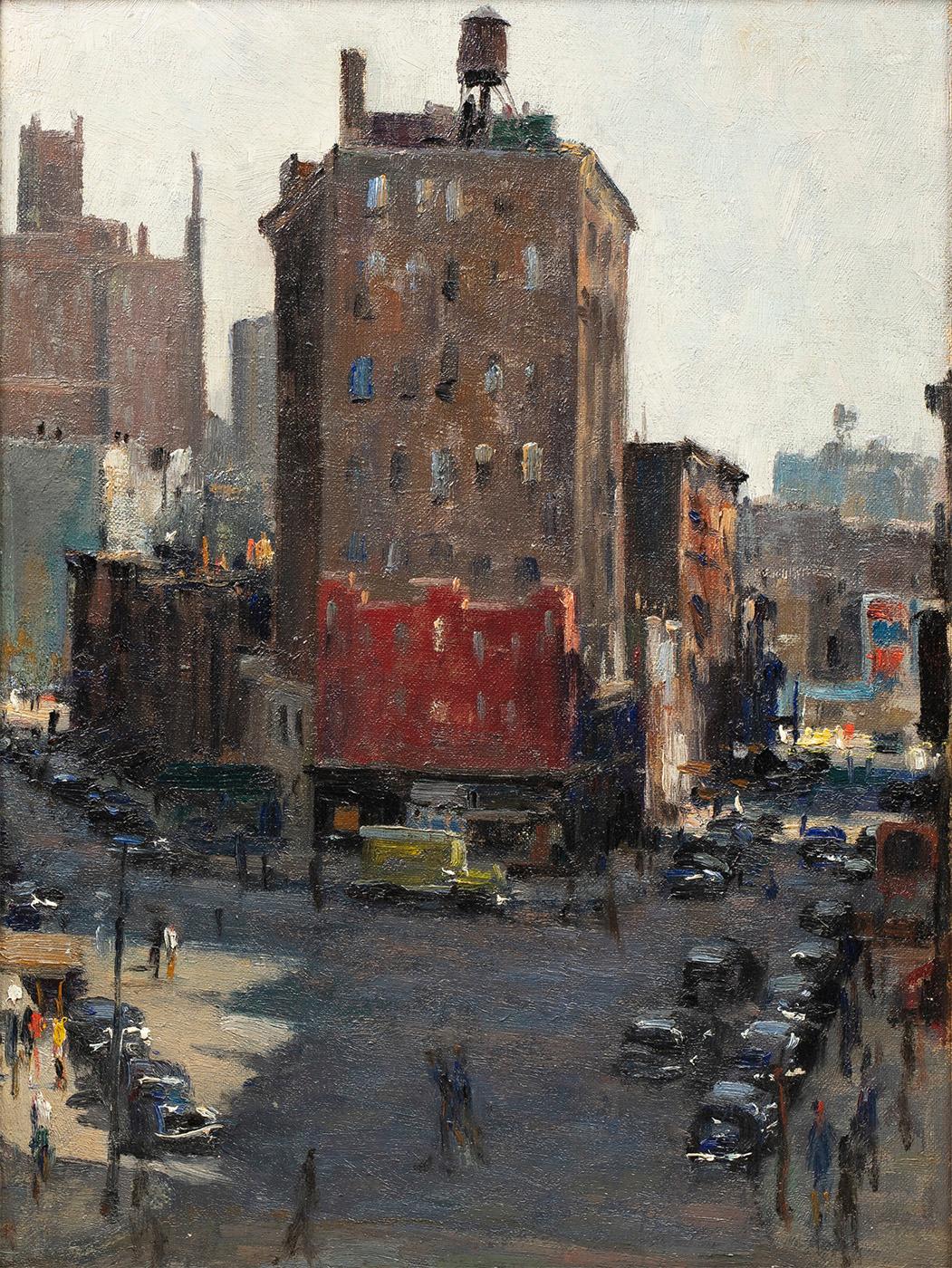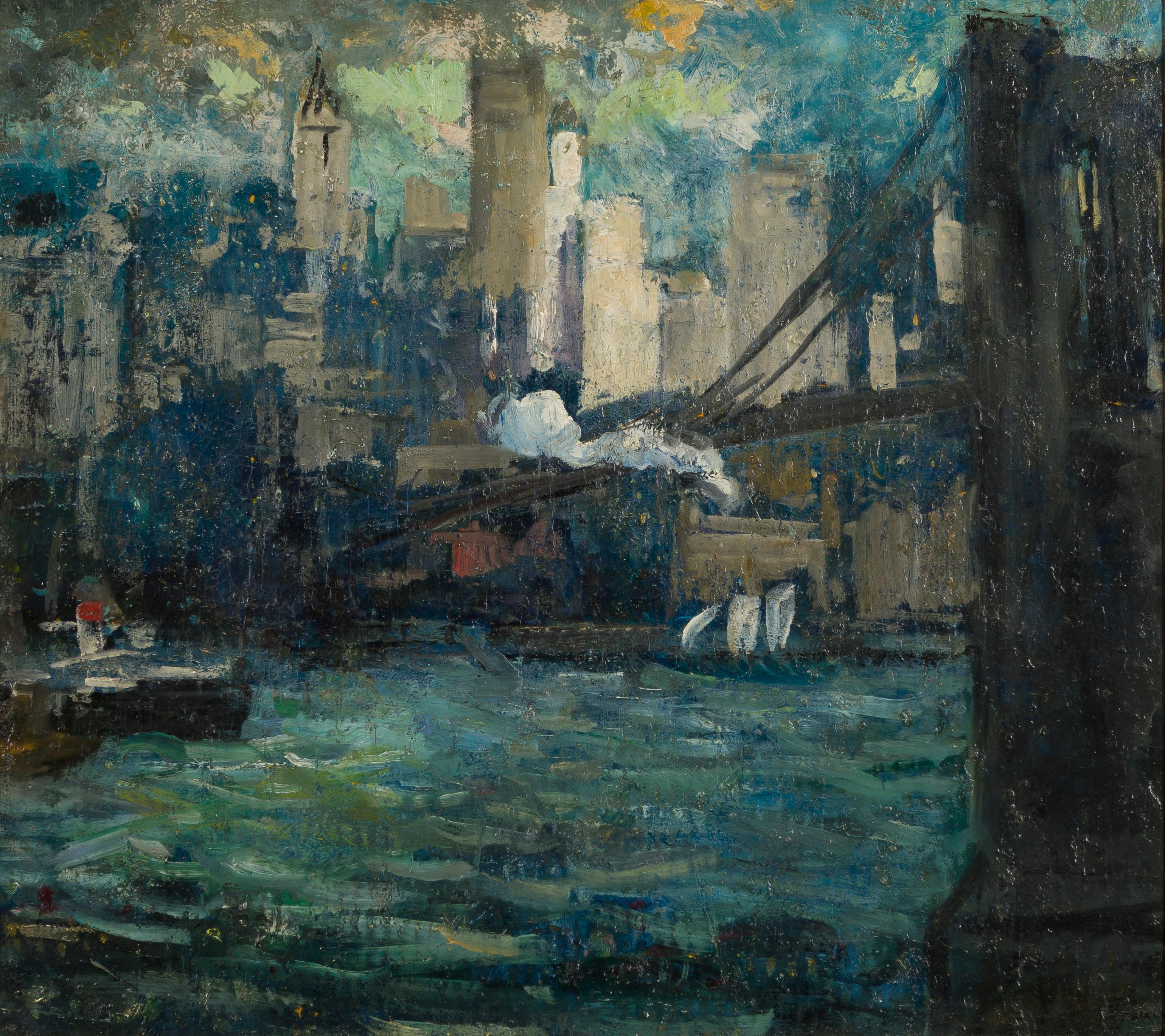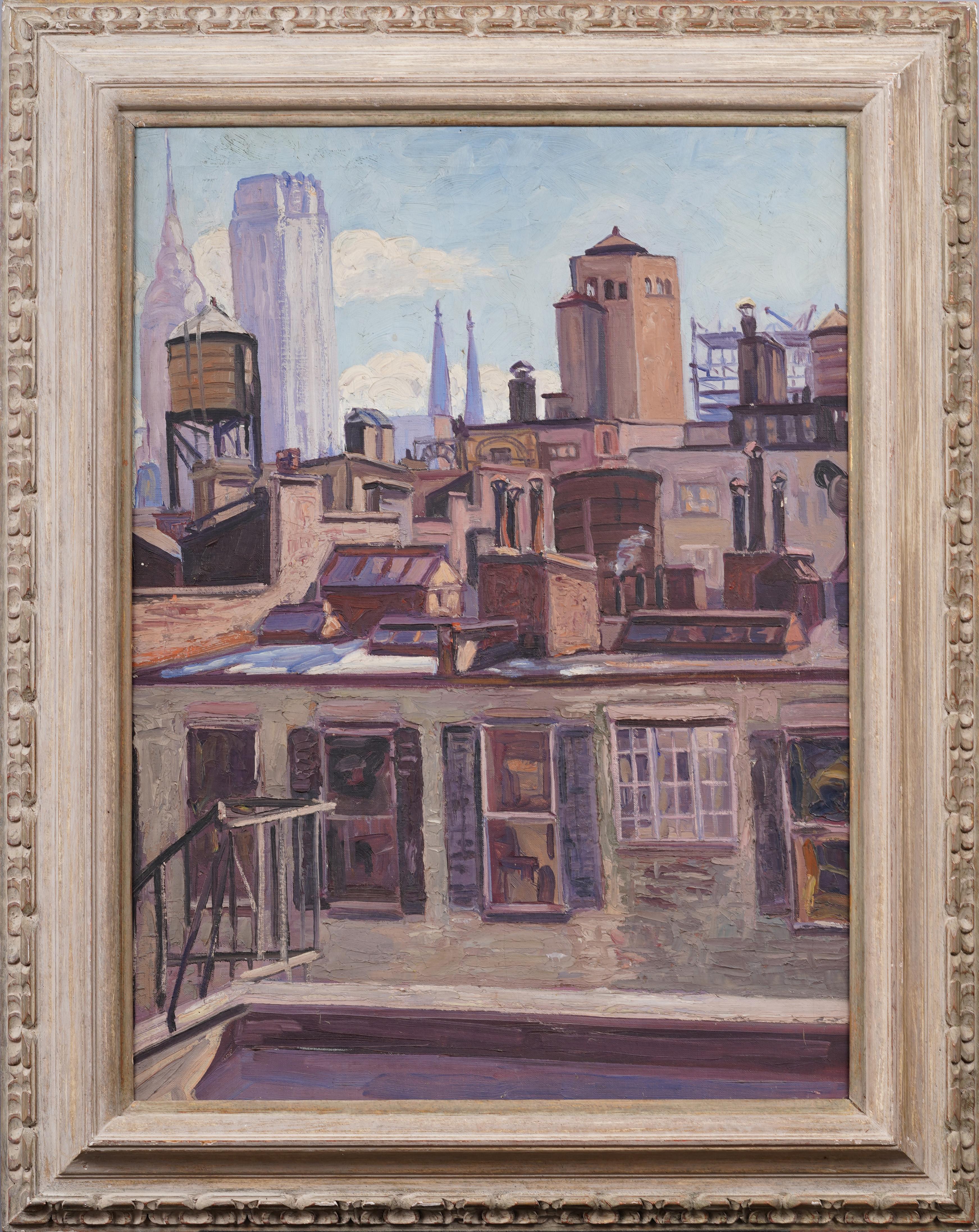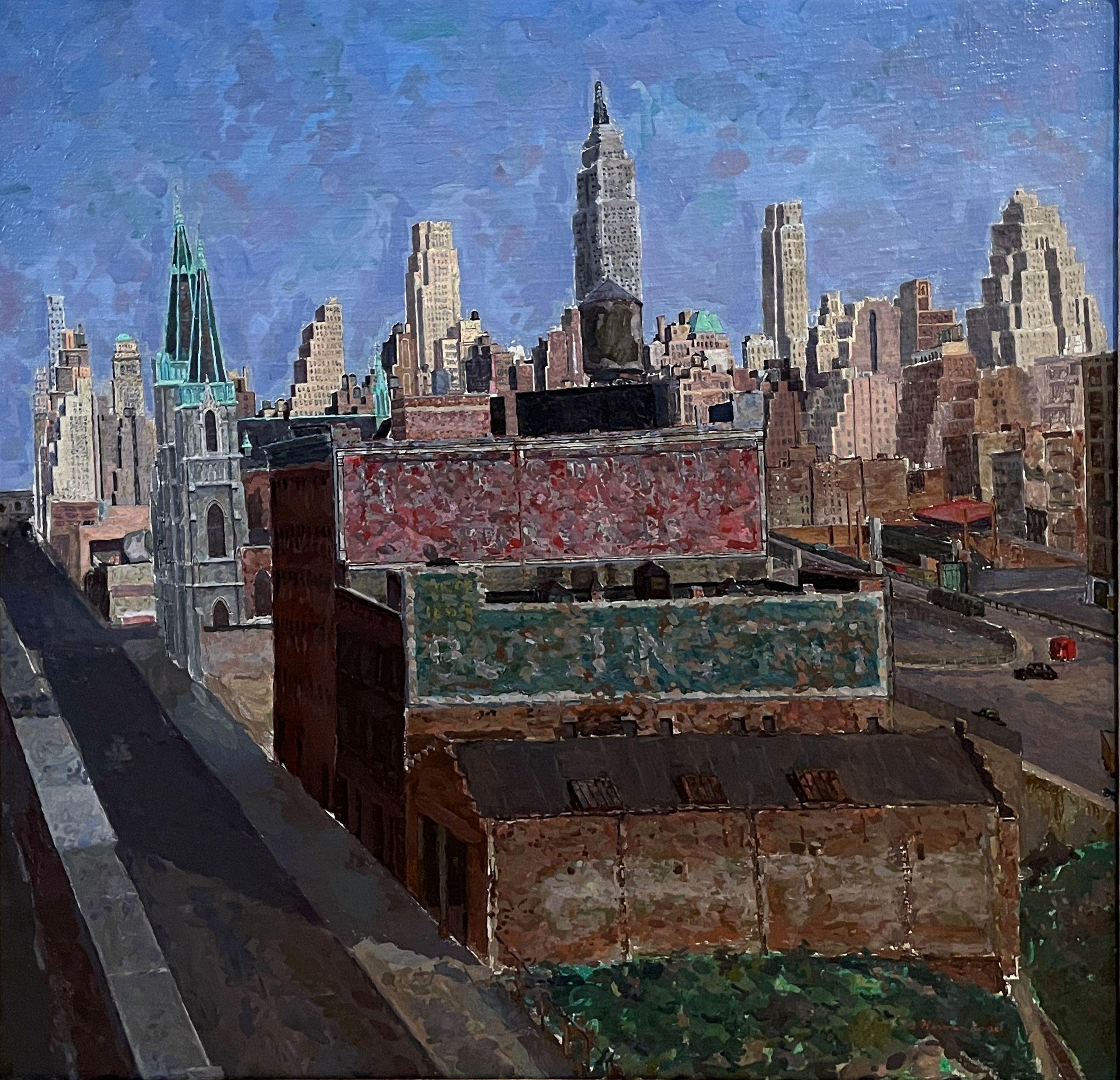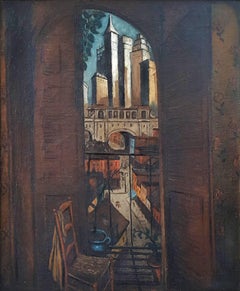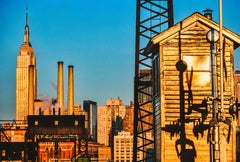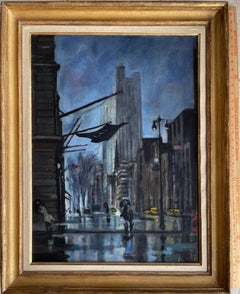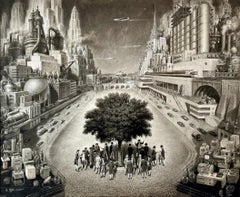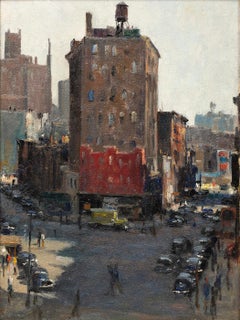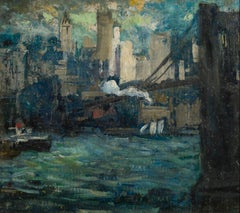Items Similar to New York Skyline the West Side with Hudson River - Vintage New York
Video Loading
Want more images or videos?
Request additional images or videos from the seller
1 of 12
Frank S. HermannNew York Skyline the West Side with Hudson River - Vintage New York1935 circa
1935 circa
$6,500
£4,882.98
€5,630.87
CA$9,019.60
A$10,022.76
CHF 5,252.03
MX$122,911.32
NOK 66,986.64
SEK 63,018.57
DKK 42,026.44
Shipping
Retrieving quote...The 1stDibs Promise:
Authenticity Guarantee,
Money-Back Guarantee,
24-Hour Cancellation
About the Item
Rooftop view of the upper West Side Manhattan as it looked in the 1930s. There is a rough indication of a billboard and a glimpse of the Hudson River. The cluster of buildings depicted function both as representation and abstraction painting. Scenes of Old New York have a wide following and are perhaps linked to nostalgia since most of Old New York is being destroyed. Signed lower right, Framed behind glass. The medium appears to be a mix of gouache and oil or perhaps some mixed media unique to the artist. There is some impasto evident. The work is best view under top gallery lighting to bring out color and detail
- Creator:Frank S. Hermann (1866 - 1942, American)
- Creation Year:1935 circa
- Dimensions:Height: 13.5 in (34.29 cm)Width: 18.24 in (46.33 cm)
- Medium:
- Movement & Style:
- Period:
- Condition:The condition is Good / Fair. Some desaturation of color and scattered craquelure are visible mostly on close inspection. There is light surface grime. The frame is inexpensive yet still has a very moodly quality.
- Gallery Location:Miami, FL
- Reference Number:1stDibs: LU385314362372

About the Seller
4.9
Gold Seller
Premium sellers maintaining a 4.3+ rating and 24-hour response times
Established in 2005
1stDibs seller since 2016
115 sales on 1stDibs
Typical response time: 1 hour
- ShippingRetrieving quote...Shipping from: Miami, FL
- Return Policy
Authenticity Guarantee
In the unlikely event there’s an issue with an item’s authenticity, contact us within 1 year for a full refund. DetailsMoney-Back Guarantee
If your item is not as described, is damaged in transit, or does not arrive, contact us within 7 days for a full refund. Details24-Hour Cancellation
You have a 24-hour grace period in which to reconsider your purchase, with no questions asked.Vetted Professional Sellers
Our world-class sellers must adhere to strict standards for service and quality, maintaining the integrity of our listings.Price-Match Guarantee
If you find that a seller listed the same item for a lower price elsewhere, we’ll match it.Trusted Global Delivery
Our best-in-class carrier network provides specialized shipping options worldwide, including custom delivery.More From This Seller
View AllFrom a Balcony
By Glenn O. Coleman
Located in Miami, FL
Exhibited: New York Society of Artist
Sid Deutsch
Owings-Dewey Fine Art
It's Skyscraper City: 1918. The artist depicts a simultaneous interior and exerterior view..
Based on Cole...
Category
1920s American Modern Landscape Paintings
Materials
Oil
Manhattan from Long Island City, Fine Art Photography
By Mitchell Funk
Located in Miami, FL
Signed and dated on lower right, numbered on verso, 2/15 Printed later, other size available, unframed - Printed on Hahnemühle Fine Art paper
Category
1970s American Impressionist Landscape Photography
Materials
Photographic Paper, Archival Ink, Archival Paper, Archival Pigment
New York City Rainy Night Street Scene in Blue
By Bernard Lamotte
Located in Miami, FL
Moody blue night with rain and wind rendered in a post-impressionist style somewhat like that of Albert Marquet
Category
1950s Post-Impressionist Landscape Paintings
Materials
Canvas, Oil
Futurist Vision - Mid-Century New York Skyline - Industrial Progress
Located in Miami, FL
Rarely do you come across a work of art that is vastly different than just about anything you see. This work is undeniably brilliant and a sheer pleasure to behold. Alexander Leydenfrost...
Category
1950s Art Deco Landscape Paintings
Materials
Gouache, Board, Graphite, Charcoal
Morningside Park, Old New York - Cathedral of St. John the Divine
By Lucille Corcos
Located in Miami, FL
Corcos paints what appears to be the northern part Central Park from an elevated view looking northwest. The artist used a restricted palette of warm browns and grays with heavy outl...
Category
1920s Modern Landscape Paintings
Materials
Canvas, Masonite, Oil
Winter Evening Fifth Avenue - New York at Night
By Ernest Fiene
Located in Miami, FL
Ernest Fiene depicts Fifth Avenue looking down from 57th Street with an unobstructed view of the Empire State Building. The absence of newer glass and steel architecture gives the painting the charm of old New York. The artist captures a dark, moody blue sky as light bounces back from the clouds. This contrasts with the somewhat haunting yellow glow given to pedestrians and street traffic. The people have somewhat of a zombie quality akin to George Tooker. Best viewed with a top and direct gallery light...
Category
1950s Post-Impressionist Landscape Paintings
Materials
Canvas, Oil
You May Also Like
View of New York - Post Impressionist Oil, Cityscape by Jacques Martin-Ferrieres
By Jacques Martin-Ferrières
Located in Marlow, Buckinghamshire
A stunning oil on canvas urban landscape by sought after French post-impressionist painter Jacques Martin-Ferrieres. The piece depicts a very rare view of the Manhattan skyline - pai...
Category
1940s Post-Impressionist Landscape Paintings
Materials
Canvas, Oil
"Manhattan from the Rooftops" Nathan Hoffman, Impressionist Cityscape Landscape
Located in New York, NY
Nathan Hoffman
Manhattan from the Rooftops, July 1, 1947
Signed, dated and estate stamped on the reverse
Oil on board
15 3/4 x 20 inches
Born in Russia...
Category
1940s American Impressionist Landscape Paintings
Materials
Oil, Board
New York City View
Located in New York, NY
On verso: NY City View / ARTIST: MIRA
Category
20th Century American Modern Landscape Paintings
Materials
Oil
New York Skyline
Located in Boston, MA
Canvas measures 23.5 x 26.5 inches. Brooklyn Bridge is seen in the foreground. Lower Manhattan skyline in distance.
Fred Wagner, a Philadelphia, PA painter and teacher was born in Valley Forge, PA on 20 December 1864 and died on 14 January 1940. He studied with Thomas Eakins at the Pennsylvania Academy of Fine Arts...
Category
1910s American Impressionist Paintings
Materials
Canvas, Paper, Oil
Antique American Impressionist New York Cityscape Framed Large Oil Painting
By Allen Tucker
Located in Buffalo, NY
Impressive early American impressionist cityscape oil painting attributed to Allen Tucker (1866 - 1939). Framed. Oil on canvas. Unsigned. Image size, 30H by 22L.
Category
1960s Abstract Landscape Paintings
Materials
Canvas, Oil
$5,400 Sale Price
20% Off
"Manhattan Looking East, " Herman Rose, WPA New York City View from Midtown
By Herman Rose
Located in New York, NY
Herman Rose (1909 - 2007)
Manhattan Looking East (View from Midtown), 1952-54
Oil on canvas
26 x 28 inches
Signed lower right
Fairfield Porter wrote an essay in ArtNews on this exact painting in 1955. Please inquire for a copy of the article.
Literature:
Fairfield Porter, "Herman Rose Paints a Picture," ArtNews, April 1955 Volume 54, Number 2, illustrated.
Herman Rose was best known for his depictions of cityscapes of New York City. Herman Rappaport was born in Brooklyn, New York. in 1909. Herman Rose was the professional pseudonym of Herman Rappaport. Originally trained as a draftsman and studied at the National Academy of Design from 1927 to 1929, he was later employed by the Works Progress Administration's Murals Division under Arshile Gorky from 1934 until 1939. In 1939, after experimenting with a variety of contemporary expressionistic styles, Rose decided to paint from life. Working mostly in East New York and East Canarsie in Brooklyn, and in Manhattan, Rose began to paint roof tops and street scenes.
Rappaport began using the name Herman Rose when he held his first solo art exhibition in 1946 at the Charles Egan Gallery in New York City. Although he initially began as an Expressionistic painter, he became known for small, light-filled Impressionist paintings of still life, cityscapes and skies by the early 1950s. His paintings and images were often composed of very small dabs of paint and tiny, blurry "squares," which combined to create the image on canvas, his favorite medium. Often described as a "lyrical painter" Rose's work "interpreted traditional subjects: landscape, still life and the figure like the Post-Impressionists from whom he developed his own style, Rose built up forms from distinct touches of color that don't entirely blend in the viewer's eye. This gives his surfaces an active quality that flattens forms, one of the great lessons of modernism."
Herman Rose's work received official recognition when Ms. Dorothy Miller of Museum of Modern Art (MoMA) included his work in an exhibition called, "15 Americans," alongside work by Clyfford Still, Mark Rothko and Jackson Pollock.
New York Times art critic Hilton Kramer wrote of Rose's work in 1981, "{he} must surely be counted among the most beautiful works anyone has produced in this challenging medium for many years." The Art in America art critic Lawrence Campbell...
Category
1950s American Modern Landscape Paintings
Materials
Canvas, Oil
More Ways To Browse
New York Skyline Painting
Vintage Billboards
New York Rooftop Art
Frank Hudson
Manhattan Skyline Oil Painting
Manhattan Skyline Vintage
Contemporary Maine Landscape Paintings
Oil Painting Marsh
19th Century Landscape Unsigned
Children On Beach Oil Painting
19th Century Maritime Art
Alley Painting
Golfing Paintings
Mexican Art 1920s
Mexico Art 1920s
Pasture Painting
Virginia Landscape Oil Painting
17th Century Italian Landscape
